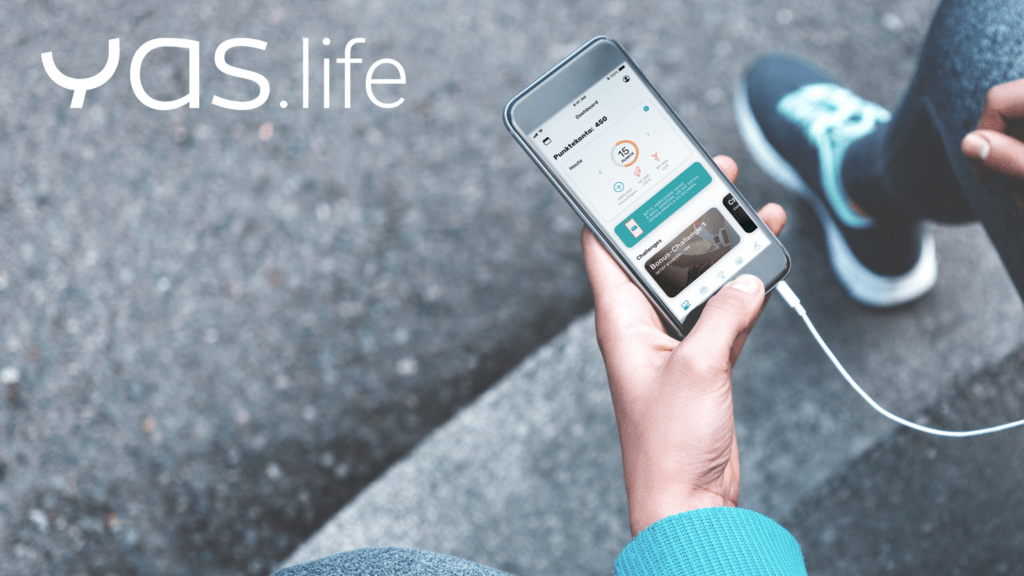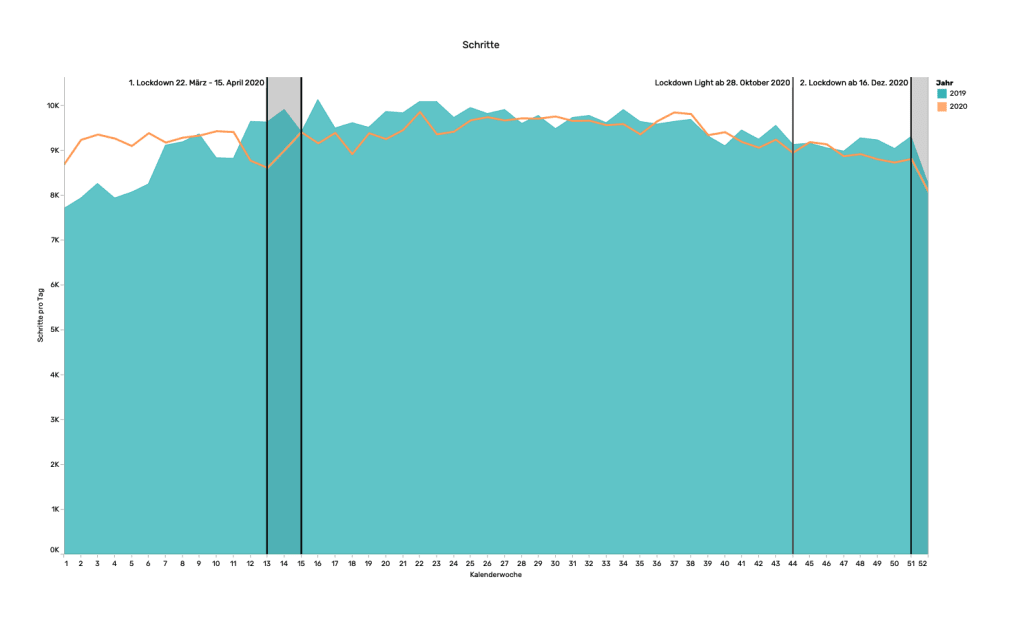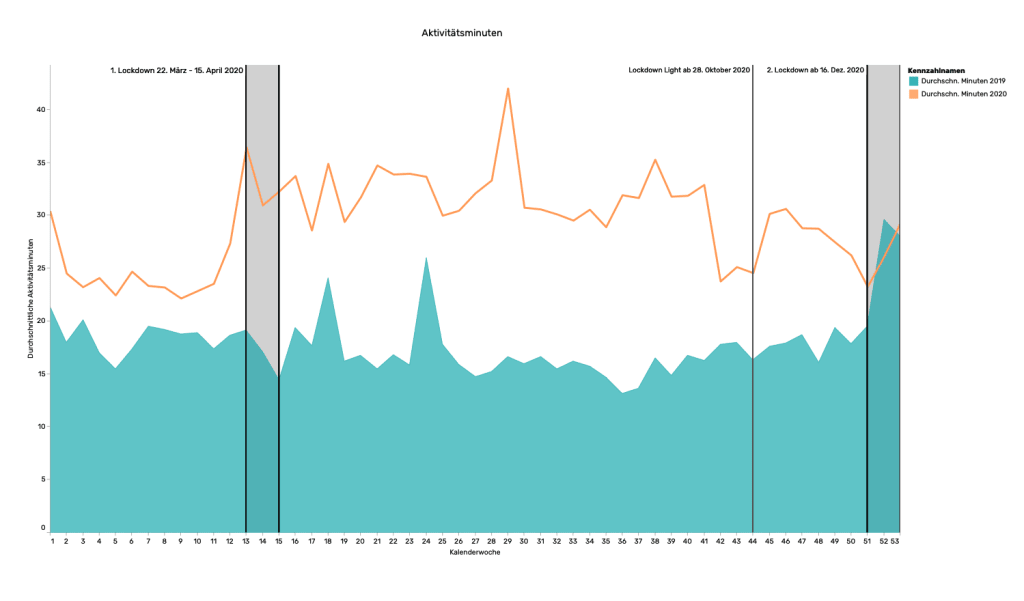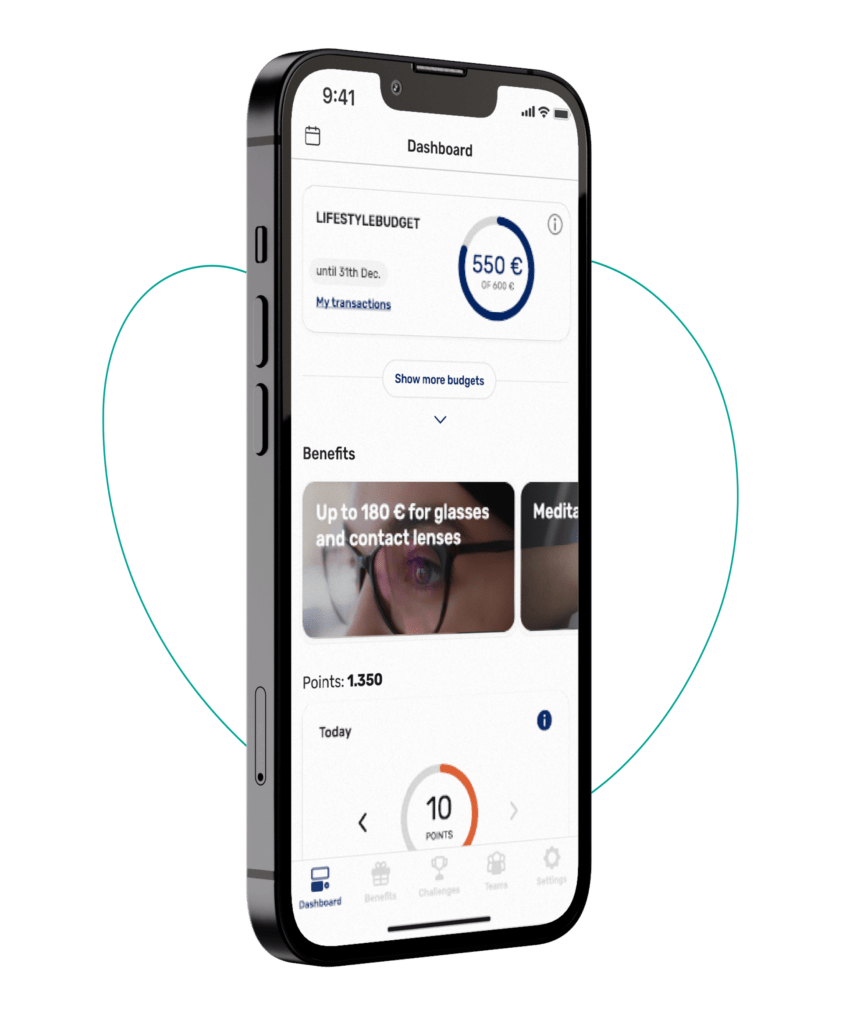
The importance of health apps in maintaining physical activity during the covid 19 pandemic.
The health consequences of the Covid 19 pandemic, which has now lasted for more than a year, are considerable. While on the one hand the direct illnesses caused by the coronavirus are significant, on the other hand the indirect health effects – due to the necessary protective measures and associated restrictions – must also be taken into account. In this country, health has been emphasized as the highest premise in the current political canon of values. The various influences on health in the course of the pandemic are complex and increasingly focus on indirect consequences such as mental illness, diabetes or back problems. In practice, the measures to prevent infection with the coronavirus and the common health-promoting measures in everyday life, such as fitness, are often at odds. A dilemma emerges: balancing health against health? In this respect, digital applications obviously play a special role in times of closed sports facilities or home offices. The article highlights in particular the aspect of physical activity, which can be mediated by low-threshold health apps.
What makes exercise valuable for health
Everyone knows it: physical activity provides significant health benefits. After all, evolution has programmed us for movement. Movement is an elementary building block for a healthy life: Beginning with general well-being and extending to physical, mental and social health. Physical activity is thus becoming increasingly important in terms of disease prevention and therapy. The message of the global health initiative ‘Exercise is Medicine’ is self-evident in this context.
How much exercise at least weekly?
Clear recommendations for a minimum amount of exercise to maintain health – such as the weekly 150 minutes of moderate aerobic activity – are propagated by professional organizations such as the WHO (World Health Organization, 2020).
The reality in this country, on the other hand, is that the vast majority of people fail to meet these minimum requirements (World Health Organization, et al., 2016; Froböse, et al., 2018). Consequently, the numbers are increasing, especially for the so-called widespread diseases. The two risk factors of an unhealthy lifestyle and lack of exercise are indisputably considered to be among the main causes. Those affected gradually suffer from the effects of the diseases and the associated reduction in quality of life and experience financial disadvantages due to a limited ability to work. This results in considerable additional costs for the healthcare system (Ding, et al., 2017).
Reduction of diseases through sport
Studies show what a miracle sport can be: The risk of developing 13 types of cancer can be reduced by up to 42% (Moore, et al., 2016). Active walking for 2.5 hours per week reduces the risk of diabetes by 30% in healthy individuals (Jeon, et al., 2007). Sitting, on the other hand, is pilloried as the “new smoking” and not without good reason. Those who regularly crack the eight-hour mark in sitting during the day have an 80% increased risk of death (Stamatakis, et al., 2019). And good fitness levels are associated with up to an 88% lower risk of dementia (Hörder, et al., 2018). Chronic stress can also be counteracted and prevented with exercise, especially moderate endurance sports (Gerber, et al., 2016). But not only for the general health maintenance of the body sport & exercise are indispensable, also in view of the pandemic this is an essential protective factor for the performance of our immune system. Thus, physical inactivity counts as an indirect risk factor for a severe course of COVID-19 disease.
Professional societies such as the German Society for Sports Medicine and Prevention (DGSP) caution that current physical inactivity can also have far-reaching consequences for health, such as cardiovascular disease, hypertension, and type II diabetes (Deutsche Zeitschrift für Sportmedizin, 2020).

How Corona has influenced movement behavior
Taking the bus to work, working in the office, ordering something from the delivery service in the evening – the modern world brings us a lot of electric mobility at the expense of physical activity and thus quickly into the comfort zone. While the average value is already well below the much-cited 10,000 steps per day, more like 5,000 (Althoff, et al., 2017), Corona is now completely torpedoing the striving for more activity in numerous people.
Influence of the Corona measures on movement
In times of the pandemic, anyone who looked at their fitness tracker in the evening after a day at the home office with a guilty conscience was not infrequently horrified to see a three-digit step count. The reason: restrictions on public space have drastically changed the usual opportunities for physical activity. For example, all face-to-face sports classes did not take place, gyms and other sports facilities were closed. Everyday activities were also under the influence, so walking or biking to work, daycare or school was eliminated because of home office/schooling.
Physical activity studies
Numerous national and international studies investigated the changes in physical activity, especially for the phases of the lockdowns. The measures used to contain the virus had a significant impact on people’s activity behavior. Globally, the number of daily steps decreased after COVID-19 was declared a pandemic, with regional differences evident here due to different regulatory measures (Tison, et al., 2020).
As part of the ongoing “SPOVID” project, researchers at FAU Erlangen-Würzburg are shedding light on changes in physical activity in the German population over the course of the Corona pandemic. Available results from the first lockdown illustrate a decline in leisure-time sports activities and physical activity. The distribution here showed that about one-third were less active, 27% kept activity levels roughly constant, and only 6% of people increased them (Mutz, et al., 2020). The analyses of the fitness wristband manufacturer Fitbit fit into this picture: 11% fewer steps were completed by users in March 2020 compared to March 2019 (Fitbit, 2020).
Change of movement by age
A differentiated consideration of individual characteristics such as age would appear to make sense in this context, in order to also be able to draw optimal, target group-specific conclusions. In this context, the recently published German Ageing Survey examined physical activity as part of a representative survey of people in the second half of life: Here, 30.9% of 46- to 60-year-olds stated that their physical activity had decreased during the pandemic (Nowossadeck, et al., 2021).
The fitness industry, in particular, sought a debate on the long-term health consequences of closing sports facilities and the associated ban on sports and health training. It is true that there have been selective attempts on the part of the public sector – for example, by means of temporary special regulations for the implementation of certified prevention presence courses (§20 SGB V) by digital means – to enable providers and participants to find alternatives. Nevertheless, it can be assumed that such measures are by no means sufficient to compensate for the reduced activity behavior.
What are the consequences of physical "corona inactivity"?
In connection with the Corona-related restrictions on sports/fitness, the board member of IKK Südwest and prevention expert Prof. Dr. Loth recently expressed fears of a further increase in numerous widespread diseases, which in turn could promote Corona infection, referring to the more than 1,500 new cases of type 2 diabetes that occur nationwide every day (Loth, J). Overweight/obesity and lack of exercise are among the major risk factors for type 2 diabetes, which is why experts like Loth are concerned: Since the pandemic began in March 2020, there has been an increasing trend toward obesity and physical inactivity in the population. In the case of diabetes in particular, the problem is that recovery can hardly be expected once the disease has manifested itself. This in turn means multiple complications for those affected and associated restrictions in their quality of life. Diabetics also have an increased risk of suffering a severe course of disease in the event of infection with the coronavirus. All in all, this represents a massive increase in health care expenditure for health insurance companies and the community.
The DAK sickness absence analysis (DAK, 2021) for the corona year 2020 highlights the massive changes in the incidence of illness in the working world during the pandemic. Days lost due to musculoskeletal disorders, especially back pain, increased by seven percent compared to the previous year. Mental illnesses also reached a new high. Sick leave lasted an average of 14.5 percent longer than in 2019, with the lockdown-induced lack of exercise in the home office being the main cause. However, sufficient exercise is of inestimable importance, especially in these times, as it serves to maintain physical as well as mental health.
It is not surprising that the mental state of the German population also weighs heavily on the mind. Thus according to a representative population inquiry of the pronova BKK (n=1.000) from March this yearly lives over half of humans in this country in fear and worry. At the same time, 29% say they use “sports” as a coping strategy or stress relief (pronova BKK, 2021).
What added value do digital solutions offer?
For the year 2020, i.e. during the COVID-19 health crisis, there was a significant increase in interest in health apps worldwide (Statista, 2021). As described at the outset, the demand for exercise offerings in digital format is currently considerable, as there are otherwise no significant alternatives for physical activity besides outdoor-based individual fitness. The prestigious American College of Sportsmedicine’s annual Global Fitness Trends 2021 underscores the influence of the COVID-19 pandemic (Thompson, 2021): in first place was online exercise, followed directly by wearable technology (fitness trackers, smartwatches, etc.). Virtual sports courses have become indispensable for many users.
Transformation from analog to digital
While the major changes in the health fitness industry meant a bitter decline in membership numbers for the first time in years (Statista, 2021), they gave this sector a huge boost in terms of innovation and digitization. The overall usage rate of these new opportunities was high. Advantages and disadvantages must always be discussed and weighed up. For example, individual, professional correction during exercise execution by coaches cannot be optimally guaranteed without physical presence. On the other hand, participants gain a high degree of spatial and temporal flexibility. The bottom line, however, was to offer contemporary solutions in the short term in the shadow of the pandemic, but also in the long term, which do justice to developments such as the modern working world.
Trend toward health apps
There are more and more people who also feel addressed by the offers of low-threshold health apps with lifestyle & fitness character. Mobile applications (apps) in particular are aimed at the regular, usually daily practice of a defined health behavior and thus help us to achieve our (outcome or behavioral) goals. Even more so than digital course formats, apps focus on the sustainable anchoring of a health behavior in everyday life. Studies provide encouraging evidence of the positive impact of using fitness tracking apps to promote health behaviors (Gabbiadini, et al., 2019).
Health promotion through digital prevention
The increasing value of apps for prevention is also reflected in the legal requirements. For example, the Guidelines on Prevention in accordance with Section 20 of the German Social Code (SGB V) of the National Association of Statutory Health Insurance Funds (GKV Spitzenverband) were just supplemented in December 2020 with the new and now independent Chapter 7 “Digital Prevention and Health Promotion”. The hitherto joint regulation of all measures for individual behavior-related prevention (analog & digital) is thus obsolete. The amendment now also provides for a stronger qualitative focus, so that evidence of the health benefits of the offerings must be provided on the basis of a standardized study design.
Strengthen motivation through digital approaches
In this context, the use of standardized behavior change techniques and gamification are considered promising approaches for health-related behavior change. Gamification means “the transfer of game-typical elements and processes into non-game contexts with the aim of changing behavior and increasing motivation among users” (Bendel). Scientific studies prove positive effects for motivation, performance and long-term engagement. Tolks et al. see particular potential for the use of gamification where the basic motivation of users is rather low. Activities that sometimes seem monotonous and boring to users without an app (e.g., more everyday exercise through daily steps) can be given more meaning through gamification. Taking a brisk walk for half an hour a day sounds feasible, especially in times of pandemic, because at first glance the home office gives users more time for everyday exercise. In practice, however, it is difficult to integrate this into fixed daily structures, especially from a motivational point of view. Health apps and, in particular, their challenge feature seem to make all the more sense. The English word “challenges” has already become firmly anchored in our linguistic usage. A simple Google search from “Challenges + Corona” yields nearly a billion hits!!! The Corona pandemic is undoubtedly a major challenge. But especially in this case, the term challenge also contains an encouraging, positive, motivating momentum, in the sense of drive to change, let’s tackle it or according to the vernacular: You grow with the challenge.
Digitalization in occupational health management
Digitalization has also arrived in the setting of workplace health promotion, and not just since Corona, but in the wake of the pandemic, digital offerings have experienced another significant boost. Germany’s leading platform for workplace health promotion measures – Machtfit – reports a drastic increase in its digital offerings from 6,500 (2019) to 23,000 (2020) users. Companies face the great challenge of promoting the health of their employees and keeping motivation high despite the physical distance in remote status. If the active break in the office or the company running event are not an option in lockdown, team-internal step challenges via app, which also enable competitions between departments, for example, can act as a true motivation driver.

A case study: YAS.life - Motivation to move
Under the name YAS.life, MAGNUM EST Digital Health GmbH develops digital applications as white label solutions for health insurance companies, insurance companies and companies in the field of health management. Physical activity and diligence should not only be physically rewarding: YAS.life offers its own innovative fitness app as a bonus program. With its help, users can receive various rewards for physical activity, healthy eating, mindfulness or preventive care. The company’s long-term goal is to motivate more people to lead a healthy lifestyle and, together with its partners, to offer attractive long-term benefits for physically active people. In the future, the company wants to create even more synergies together and use the app to inspire customers to lead an active lifestyle and reward them at the same time.

Fig.1 Comparison of the number of steps in the course of the years 2019 and 2020 for users of the YAS app.

Fig. 2: Comparison of activity minutes over the course of 2019 and 2020 among users of the YAS app.
Steps taken by YAS app users in 2020 compared to 2019
To what extent can digital companions provide a health benefit? Figures 1 and 2 show how well the YAS app works and fulfills its motivational mission. First, the physical activity behavior in the form of daily steps before (2019) and during the COVID 19 pandemic is shown. Contrary to the general trend – the drop in physical activity during the corona crisis – this shows no meaningful change. YAS users accumulate the same number of steps as before the pandemic (ØΔ steps2019/2020 = -0.12%).
Activity duration
Figure 2 illustrates the duration of trackable physical activity such as cycling, running or yoga. Here, there was even a significant increase in physical activity of about 70%. Despite temporary contact restrictions and movement limitations, new or alternative forms of exercise were obviously used to a high degree.
As a consequence, the users of the YAS app, which is equipped with numerous gamification elements such as statistics feature, health-goal setting or learning quizzes, managed to increase their fitness activities in the long term during the Corona Year 2020 phase, which is prone to physical inactivity, and thus to reduce a significant risk factor for chronic diseases.
Outlook
Through long, restrictive phases of lockdown with its numerous virtual activities, we all yearn above all for the “together & out”. Although the Corona crisis will hopefully soon be defeated by comprehensive vaccination measures, many developments such as home offices and the associated elimination of commuting to work will remain an ongoing issue. People may long for the “real” visit to the yoga studio. But the wheel of digitalization will not turn back and therefore online courses, individual coaching via Zoom & Skype will by no means disappear, but rather expand the offer. In particular, mobile applications in the form of preventive fitness/wellness/lifestyle apps will remain a meaningful building block for individual health promotion post Corona and will continue to grow in importance. The question of how many steps have I already taken today has become a habit for many of us. Contrary to the corona blues and its online fatigue, it is important to emphasize that the app medium with its low-threshold motivation may belong to the digital world in connection with the actual physical activity – the DOING – but it is mostly analog, low-noise, incidental and happens outdoors.
In the field of workplace health promotion, experts have long seen future solutions in the coexistence or linking of analog and digital solutions (Baxheinrich, et al., 2018). Digital offerings increase the reach and availability of measures. They also conserve resources and are flexible in terms of time and space. Decentralization and a wide variety of working time models are thus no longer a problem. Analog offerings also benefit when they are linked to digital offerings, thereby supporting better practical transfer of what has been learned, for example.
Prevention and health promotion in living environments in accordance with Section 20a of the German Social Code, Book V (setting approach) is also undergoing a fundamental digital transformation. At first glance, the use of digital health technologies seems to focus on the individual level and thus tends to be limited as a puzzle piece of complex public health campaigns such as the WHO Healthy Cities. However, digital developments are changing the living environments themselves (e.g., digital study programs, eSports offerings, online-based neighborhood forums). There is currently still a lack of practical, political and scientific discussion of the significance of digitization for health promotion and digitized lifeworlds.
Not only because of Corona, but increasingly because of the pandemic, potentials in the area of digital health promotion are becoming apparent for insurance companies, health insurers and companies. As described, low-threshold health apps make a significant contribution to reducing the risk factor of physical inactivity and the associated chronic diseases and their subsequent costs.
About the authors
Dr. Magnus Kobel has been working in the insurance industry for more than 15 years. After holding positions at Allianz, he worked for many years as a strategic management consultant – most recently at Deloitte Consulting – with a focus on health insurance. In 2016, Magnus Kobel founded MAGNUM EST Digital Health GmbH and has since been developing digital applications for health insurers, insurance companies and companies in the field of health management as well as prevention with YAS.life.
Matthias Jaworski is a sports scientist and health manager at YAS.life. For the sports scientist and former competitive athlete, everything revolves around the three major topics of endurance sports, health and prevention. Having turned his hobby into a profession at the peak of his athletics career, he now transfers his expertise as a health manager to the digital world of YAS.life and is also active as an endurance expert and coach.
Sources
Althoff, T, Sosič, R und Hicks, J. 2017. Large-scale physical activity data reveal worldwide activity inequality. Nature. 2017, Bd. 547, S. 336–339.
American College of Sports Medicine. https://www.exerciseismedicine.org/. [Online]
Baxheinrich, A und Henssler, O. 2018. Auf dem Weg zum BGM 4.0: Verknüpfung der analogen und digitalen Welt – Chancen und Grenzen für das Betriebliche Gesundheitsmanagement. [Buchverf.] D Matusiewicz und L Kaiser. [Hrsg.] Essen, Deutschland FOM Hochschule für Oekonomie & Management. Digitales Betriebliches Gesundheitsmanagement – Theorie und Praxis. 2018, S. 301-321.
Bendel, O. https://wirtschaftslexikon.gabler.de/definition/gamification-53874. Gamification – Definition.
DAK. 2021. DAK Krankenstands-Analyse 2020. 2021.
Deutsche Zeitschrift für Sportmedizin. 2020. https://www.zeitschrift-sportmedizin.de/dzsm-mitteilungen/dgsp-warnt-vor-inaktivitaet-waehrend-der-coronavirus-pandemie/. [Online] 2020.
Ding, D, et al. 2017. The economic burden of physical inactivity: a systematic review and critical appraisal. British Journal of Sports Medicine. 2017, Vol. 51 (19), S. 1392-1409.
Fitbit. 2020. The Impact Of Coronavirus On Global Activity. 2020.
Froböse, I, Biallas, B und Wallmann-Sperlich, B. 2018. Der DKV-Report 2018 – Wie gesund lebt Deutschland? s.l. : DKV Deutsche Krankenversicherung, 2018.
Gabbiadini, A und Greitemeyer , T. 2019. Fitness mobile apps positively affect attitudes, perceived behavioral control and physical activities. The Journal of Sports Medicine and Physical Fitness. 2019, 59(3), S. 407-414.
Gerber, M, et al. 2016. Fitness Moderates the Relationship between Stress and Cardiovascular Risk Factors. Medicine and Science in Sports and Exercise. 2016, 48(11), S. 2075-2081.
GKV-Spitzenverband. 2020. Leitfaden Prävention – Handlungsfelder und Kriterien nach § 20 Abs. 2 SGB V. 2020.
Hörder, H, et al. 2018. Midlife cardiovascular fitness and dementia – A 44-year longitudinal population study in women. Neurology. 2018, 90(15).
Jeon, C, et al. 2007. Physical activity of moderate intensity and risk of type 2 diabetes: a systematic review. Diabetes Care. 2007, 30(3), S. 744-52.
Loth, J. “Hypothek für die Zukunft” – Interview Cityradio Saarland vom 22.01.2021.
Machtfit. 2021. Gesundheitsbranche 2.0 – Trends für 2021. 2021.
Moore, S, Lee, I und Weiderpass, E. 2016. Association of Leisure-Time Physical Activity With Risk of 26 Types of Cancer in 1.44 Million Adults. JAMA Internal Medicine. 2016, 176(6), S. 816-825.
Mutz, M und Gerke, M. 2020. Sport and exercise in times of self-quarantine: How Germans changed their behaviour at the beginning of the Covid-19 pandemic. International Review for the Sociology of Sport. 2020.
Nowossadeck, S, Wettstein, M und Cengia, A. 2021. Körperliche Aktivität in der Corona Pandemie: Veränderung der Häufigkeit von Sport und Spazierengehen bei Menschen in der zweiten Lebenshälfte. DZA aktuell – Deutscher Alterssurvey. 2021, 3/21.
pronova BKK. 2021. Die Süchte der Deutschen. 2021.
Stamatakis, E, et al. 2019. Sitting Time, Physical Activity, and Risk of Mortality in Adults. Journal of the American College of Cardiology. 2019, 73(16), S. 2062-2072.
Statista. 2021. Wegen Corona: Fitnessstudios verlieren Mitglieder. Mitglieder von Fitnessclubs in Deutschland (in Mio.). 2021.
Statista. 2021b. Zuwachs bei heruntergeladenen Gesundheit-Apps im Zuge der COVID-19-Pandemie nach Ländern im Jahr 2020. 2021.
Thompson, W. 2021. Worldwide Survey of Fitness Trends for 2021. ACSM’s Health & Fitness Journal. 2021, 25(1), S. 10-19.
Tison, G, et al. 2020. Worldwide Effect of COVID-19 on Physical Activity: A Descriptive Study. Annals of Internal Medicine. 2020, 173(9).
Tolks, D, et al. 2020. Spielerische Ansätze in Prävention und Gesundheitsförderung – Serious Games und Gamification. Bundesgesundheitsblatt – Gesundheitsforschung – Gesundheitsschutz. 2020, 63, S. 698-707.
World Health Organization und European Commission. 2016. Germany Physical Activity Factsheet. 2016.
World Health Organization. 2020. WHO guidelines on physical activity and sedentary behaviour. 2020.
Follow us for more news on bKV, employer branding and digital health

